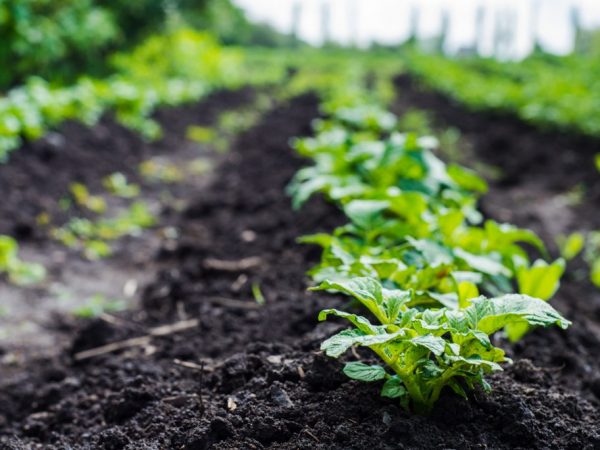Characteristics of the potato variety Lyubava
The Lyubava potato is a popular varietal variety of nightshade crops among summer residents who grow vegetables in their backyards. Observing all the recommendations and rules for caring for plants, you can get a high yield.

Characteristics of the potato variety Lyubava
Features of the variety
A description of the varietal characteristics of the Lyubava potatoes will help to properly care for the plant and get a good yield. The potato variety Lyubava is characterized by medium growth, bushes of intermediate typical growth, semi-erect stems. Floral reddish-purple corollas are of medium size. The leaves are small, open.
Potatoes of the Lyubava variety ripen early. The period from germination of the first shoots to technical maturity ranges from 70 to 75 days. The tubers have a medium density red rind. A characteristic feature of the potato is its oval-round shape and shallow eyes. On average, the potato variety Lyubava has a mass of tubers from 110 to 215 g. The pulp contains up to 16.9% starch.
Advantages and disadvantages
The characteristic of the Lyubava variety is distinguished by a large number of quality indicators. This proves that this potato has some superiority over other potato varieties.
Seed potatoes Lyubava has the following advantages:
- excellent taste;
- large fruits;
- varietal marketability is up to 98%;
- simultaneous formation of tuberous groups;
- on average, tubers contain 1.5% more starch than standard varietal crops of the genus Solanaceae;
- resistance to the development of cancer cells in tubers;
- high drought tolerance.
The disadvantages of this culture include low resistance to some diseases. In the process of growing the variety Lyubava, potato tops should be processed. This varietal variety is susceptible to the golden nematode and often the bushes are affected by late blight.
Landing
The plant belongs to the group of early varietal varieties that are grown to obtain double the yield from one planting site. To obtain the earliest harvest possible, the tubers should be germinated 1.5 months before planting in the ground.
Soil preparation

The soil for planting needs to be prepared
In order for the plant to develop well and bear fruit, proper conditions must be provided. In the fall, you need to decide on which site the potatoes will be grown next year in order to properly prepare the soil.
Features of soil preparation:
- The landing site is dry and protected from the negative effects of cold northerly winds.
- The soil for planting is of a light sandy loam or loamy type.
- The predecessors for growing crops are different types of root crops, cucumbers.
- Before planting the tubers, about 300 g of humus and 25 g of wood ash are poured into the hole.
On the site in the autumn, it is not recommended to break the soil into small clods.Large soil fractions will freeze better in winter, and with them the remains of weed seeds, as well as pest eggs.
Planting
The characteristic of the Lyubava variety implies an early planting of a vegetable crop. The optimal time is mid-April, at which time the soil warms up well up to 12 cm. In unfavorable weather conditions, frost, planting is recommended to be postponed for some time.
Seed potatoes are planted in this way:
- Planting depth of potato tubers - 10-12 cm.
- The distance between the holes is at least 40 cm.
- The distance between the rows is about 90 cm.
- Rotted manure or compost substrate is poured into the hole.
- The tubers are placed in holes and covered with fertile soil.
After planting, the plants should be watered. Each well requires 500 ml of water.
Care

The plant needs hilling
Description of agrotechnical measures for the care of the crop: timely hilling, loosening of the soil, removal of weed grasses, fertilization and watering. This varietal variety is resistant to unfavorable climatic conditions.
An important stage at the initial stage of the growing season is hilling, which acts as a protective measure against possible frost during early planting. In the southern regions, the first stage of hilling is carried out when the potato tops reach about 25 cm.
Watering
Watering potato plantings should be done infrequently, but in a large amount of water (10 liters per bush). This will moisten the soil to a depth of half a meter.
You need to water the bushes directly at the root, not on the leaves. This method of irrigation prevents waterlogging of the soil and the development of late blight. The first watering is recommended after the flowers appear. You can also water the beds two or three more times during the entire ripening period of the tubers. Watering stops 7 days before digging.
Fertilizer
For a good harvest, fertilization should be carried out. As the first feeding, a solution is used:
- 10 liters of water;
- 0.5 l mullein;
- 17 g of urea.
Under one bush, the solution is applied in an amount of half a rub. The second phase of fertilization falls on the budding period. For this, a solution is used with the addition of a small amount of wood ash.
Pest control
Potatoes of the Lyubava variety need to be treated against a number of diseases and pests.
To combat diseases, various means of chemical (insecticides) and natural origin (wood ash) are used.
Mostly bushes are affected by the Colorado potato beetle. Many gardeners collect these insects and their larvae by hand. This method of struggle today is the most effective, since the Colorado potato beetle quickly adapts to the effects of various chemicals and further affects potato bushes.
Conclusion
A description of the cultivation technique and the peculiarities of caring for plants of this varietal variety will allow you to achieve a high yield of a tasty and healthy vegetable. Potatoes are used for the preparation of first and second courses, as well as raw materials for fries and the production of chips.


